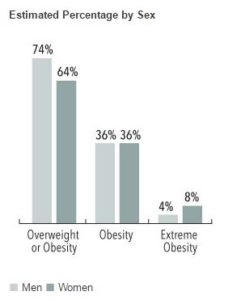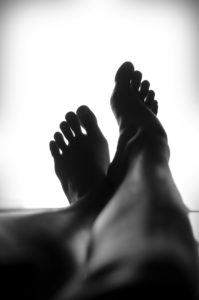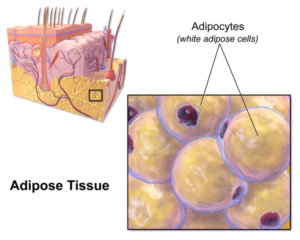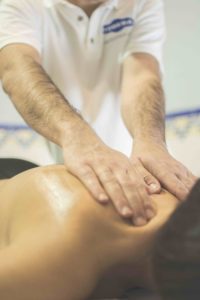By Aylah Clark, ND
“It all started in menopause. The weight started to come on gradually, primarily in my arms and legs, and I couldn’t seem to get it to go away. I tried everything. I eat a super clean diet and I work out religiously. The weight barely budges. I feel like something is wrong with me. I just don’t understand it!”
I hear this and similar stories from patients pretty regularly, with slightly different renditions. Sometimes it starts in puberty. Sometimes body pain is the chief concern. Although it isn’t always lipedema, I have to ask myself – could it be?

2009-2010 Data, NIH
According to the National Institutes of Health, 68.8% of the United States is overweight and 35.7% are considered to be obese and the numbers are rising. Obesity is not just one condition, however. It has different causes. Lipedema, Dercum’s disease, Madelung’s, and Familial Multiple Lipomatosis are 4 specific examples, but lipedema in particular appears to be far more common.
Lipedema is an under-recognized condition that may affect as many as 11% of women according to lipedema expert, Dr. Etelka Földi. One of its striking features is that the fat, primarily in the lower extremities, does not go away despite very good diet and exercise habits.
Other symptoms often include body pain or hypersensitivity, easy bruising, joint pain, and reduced mobility.
Weight loss can be challenging for many people who do not have this condition and there can be many reasons for this. Metabolic abnormalities, thyroid dysfunction, gut bacteria, sleep, stress, genetics, the right diet for you, the right macronutrient ratios for your exercise and lifestyle, nutrient timing, and more can play into this. So how do you know if you have lipedema?
Diagnosis
If you’re surprised you haven’t heard of this condition, don’t be. Many doctors don’t know about it either. Diagnosis can be tricky as well because there is not a specific test that can be done to confirm the diagnosis, and although there are imaging techniques that can show certain characteristics of the disease, these are primarily done in a research setting.
Besides ruling out other causes for weight loss challenges like those mentioned above, there are certain features that define this condition, separating it from others that may present similarly.
- Fat distribution – The fat is symmetrically distributed and is primarily in the legs, sometimes in the arms, while sparing the hands and feet. There can be a fairly definitive “cuff” line at the ankles where the fat stops. However, if there is also a problem with the lymphatic system on top of lipedema, there can be swelling in the feet as well known as lymphedema.

- Little change with diet and exercise – As previously mentioned, an important characteristic is that people who are very compliant to a healthy diet and who exercise regularly will have minimal fat loss, particularly on their legs. Diet and exercise are still incredibly important to help prevent further progression of the condition and, of course, for the other health benefits.
- Onset with hormonal change – Most women report lipedema becoming an issue after a major hormonal change such as puberty or menopause. One theory is that these hormones cause changes to how the person’s DNA is expressed called epigenetic changes.
- Pain/Tenderness – Patients with lipedema often report pain or hypersensitivity in the affected areas. This is frequently the most bothersome symptom for the patient.
- No change with foot elevation – If the swelling decreases when you elevate your feet, it is either not lipedema or lymphedema is also present.
A few things we know…
Lipedema appears to have a genetic component, especially when including only females, but we do not yet know the extent genetics play a role or which genes are involved.
Lipedema pathophysiology (the way it happens) likely involves problems with the fat cells (adipocytes) themselves but also the lymphatic system, vascular system, hormonal influences, and inflammation, but more research is needed to better understand how and why these changes happen.
Treatment
Conservative treatments include a foundation of a healthy diet and complete decongestive therapy (CDT). CDT involves manual lymph drainage (a type of massage by specialist trained to address the lymphatic system), compression bandaging/clothing, skin and nail care, and therapeutic exercises. Compression clothing is a very important component of treatment for preventing new accumulation of fluid in the tissue.
Conservative treatment should be done first, but there are surgical treatment options available such as liposuction that can also make a big difference in quality of life and symptoms in certain cases.
For more information: The Lipedema Project or see a health professional.
The content of this article is for educational purposes only and is not intended to diagnose or treat any condition.
Works Cited
Setting the Research Agenda for Lipedema: Step Towards a Cure. The Lipedema Project. New York City : The Friedman Center for Lymphedema Research and Treatment, 2015.
Diseases, National Institute of Diabetes and Digestive and Kidney. Overweight and Obesity Statistics. National Instite of Health. [Online] US Dept of Health and Human Services, October 2012.


8 Comments on “Struggling with weight loss? Lipedema may be the reason why.”
I was diagnosed lipedema last year by Dr. Emily Iker. I went there only once for I can’t afford to pay another $300 per visit. I had leg compression pump on my first visit. Up to now i have severe pains on my legs especially on my knees and back of my knees. I have difficulty when sitting for more than 15 minutes, standing and walking. I Was advised to take COQ10, lemon drops and kefir before breakfast. Then selenium magnesium vitamin c, b, d . L Argenine, fish oil pycnogenol. I bought vibration machine, leg sequential pump and also infrared light to minimize pain. I also now drink apple cider vinegar with honey, turmeric with ginger. I eat quinoa more often than white rice. Stil I’m crying because of severe pain.
I’m so sorry to hear you are still struggling with pain. We do offer supportive treatments for lipedema and accept many types of insurance. You can call our office for more details or to set up an appointment at 860-674-0111. We’d love to see how we can help!
I was recently diagnosed with Lipedema. I’m still trying to come to terms with this diagnosis as I had never heard of it – and it still feels like an “excuse to be fat” sort of thing. Upon diagnosis , I immediately hired a trainer at the gym and we’ve been working hard on my legs. Trying to prove the diagnosis or dr. wrong. I’ve been trying to watch what I eat- definitely portion control and less carbs. I’ve been at it 5 months now… I’ve only lost 1.5 lbs!
So I’m now researching more about this disorder. I’m 48, and have had hypothyroidism for 8 years , developing that after a large hormonal fluctuation after my youngest child was born. I’ve had quite a bit of hormonal issues in the past 3 years recently with a very large ovarian cyst. I’ve gained 50lb in past 3 years and struggling to lose it. I swear I look at food and gain weight. I’m really beginning to feel lost in my battle with this! I can’t ski with my family because there are no ski boots to accommodate my huge ankles and calves. I don’t wear shorts or skirts anymore. It’s getting me down.
I’m in Alaska, which finding help with this diagnosis here is proving to be very difficult. My GP has never heard of it. My ob-gyn tells me no carbs at night. I didn’t get much help from the lymphatic specialist who diagnosed me -only “ you’ll never lose this fat, just don’t gain anymore weight”. Even if he were helpful, I can’t afford his $750/ hr.
I really don t know where to go from here or what to do next.
Today I found Dr Heist’s RAD diet or I may try the paleo diet to start. What else can I do?
Has there been any evidence of juicing helping ? Or the fascia blaster?
I really appreciate any advice you can give me.
Sincerely-Kae
Hi Kae, I’m sorry you’re struggling with this. Unfortunately it can be challenging to find a doctor who is knowledgeable about the condition. http://www.lipedemaproject.org has more resources (you may have come across it in your own research). I have not heard about improvements with juicing but I have had a number of patients that have done very well with the ketogenic diet, but I do recommend that you check with your healthcare provider to help determine if this is appropriate for you. Complete Decongestive Therapy has also been helpful which is an intensive, often 2 week treatment, provided by lymphatic specialists and ordered by your doctor that involves lymphatic massage and leg and/or arm wrappings. It can be a useful addition to treatment in some patients.
Hi,
Is it possible to have lipodema mainly in your arms and knees, I have drooping upper arms with a lot of painful little nodules, I also have painful swollen knees again with nodules. I do suffer with lipomas and have had a gee removed in the past. My doctor won’t listen to me and days it’s just fat despite a very healthy Mediterranean diet.
Hi Karen,
It is possible to have upper arms and knees affected, but I would expect the area above the knees to also be affected. There are also other conditions like familial multiple lipomatosis and Dercum’s disease that may look similar to lipedema but also have the characteristic feature of lipomas.
Hi Doctor,
I believe I have lipedema. I would want to be diagnosed as I would want more information on liposuction to fix this problem..
Hi Carol,
We would be happy to help you schedule as a new patient! Please call our office at (860) 674-0111 at your earliest convenience for more information.